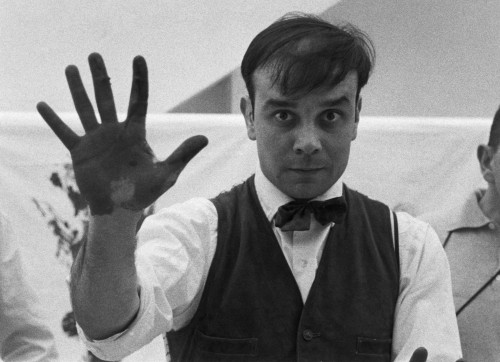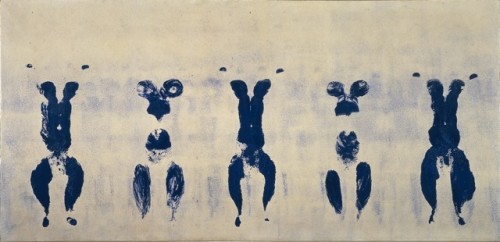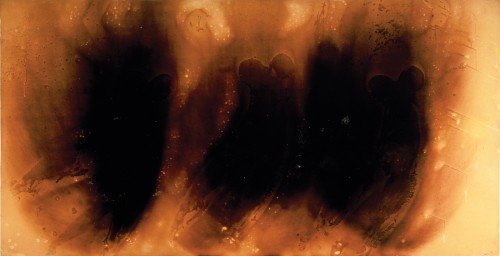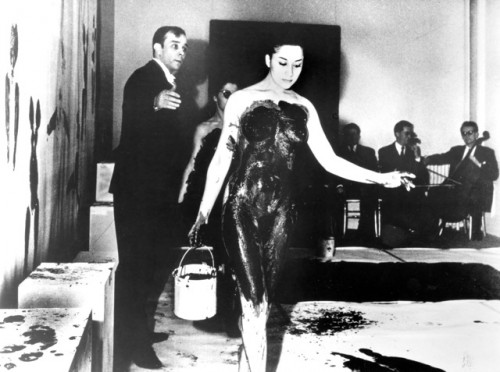Yves Klein during the filming of “”The Heartbeat of France” at Charles Wilp’s Studio, Dusseldorf, February 20, 1961. Copyright 2010 Artists Rights Society (ARS), New York/ADAGP, Paris. Image courtesy Yves Klein Archives. Photo by and copyright Charles Wilp.
“I am the painter of space. I am not an abstract painter but, on the contrary, a figurative artist, and a realist. Let us be honest, to paint space, I must be in position. I must be in space.” – Yves Klein
Yves Klein (French, b. Nice, 1928 – 1962) was much more than just an artist, he was an innovator, a visionary, and most importantly in my opinion, a dreamer. Although Klein’s notorious career only lasted a total of 8 years [he suffered a heart attack at age 34], that was all the time it would take for him to turn the art world upside down. As one of the 20th century’s most influential artists, Klein reintroduced what art and nature could be, pushing creativity beyond the traditional notions of what was accepted.
Yves Klein: With the Void, Full Powers is the first major retrospective of the artist’s work in the US in nearly thirty years. Presenting approximately 200 pieces, the Hirshhorn Museum explores a full range of Klein’s work, examining a career that radically altered the world of art.
One of my least favorite things about viewing art exhibits is that you only get to experience the artist’s end result, which granted in most cases is quite spectacular; however, it often leaves me hanging and wanting more. Yves Klein: With the Void, Full Powers provided me with the fulfillment that I have always been longing for, nothing was left unsolved – no process forgotten, no thought unexplored.
Yves Klein, “Untitled Anthropometry (ANT 100),” 1960. Hirshhorn Museum and Sculpture Garden, Holenia Purchase Fund, in memory of Joseph H. Hirshhorn, 1998 (98.23). Copyright Artists Rights Society (ARS), New York/ADAGP, Paris. Image courtesy Hirshhorn Museum and Sculpture Garden. Photo by Lee Stalsworth.
The exhibit established a range of progression, beginning with Klein’s watercolor “Theater Scenes” and ending with his diagrams/sketches. Teetering between the central transition from modern to contemporary art, Klein challenged fundamental questions about art and society, paving the way for minimalism, conceptual art, light & space art, and performance art. Painting, sculpture, performance, photography, music, architecture, writing, theater, dance, and cinema – Klein dabbled in it all during his creative practice, and the Hirshhorn did their very best to share all of his facets.
Having felt quite indifferent about the monochromatic watercolors during the first section of the exhibit, I was concerned about what was to come next; however, once you see blue, your mind becomes entranced, and you remain there till the very end of the show, fully absorbed into Klein’s world.
Klein is probably best known for his “Blue Period” in which he examined the dimensionality of pure color and even created an ultra-marine blue pigment, now known as the international Klein Blue (IKB). The Untitled Blue Monochrome (IKB 44), 1955 actually took my breath away for a second as my eyes had never seen such a vibrant and beautiful hue till that very moment. I also truly enjoyed Klein’s “Sponge Reliefs”, the way he was able to find such meaning behind an accident demonstrates his forward thinking and creative musings [he was working on a piece in blue when he realized that the sponge he was using absorbed the color, therefore, “giving the material presence”].
Yves Klein, “Untitled Fire Painting (F 81),” c. 1961 The Menil Collection, Houston. Copyright 2010 Artists Rights Society (ARS), New York/ADAGP, Paris. Image courtesy The Menil Collection, Houston.
Next came Klein’s obsession with fire, or what he liked to refer to as “the universal principle of expression”. Visions of gold, pink, and blue expressed his initial examination of the jarring temporariness of a flame, a fascination that would continually capture Klein’s interest in permanence and void. During Klein’s “Fire Period” he often times used fire as his medium of choice, replacing it or combining it with paint as he deemed fit. My favorite piece from this period in the exhibit is Klein’s Anthropometry of two models, where the outlines of their curves speak to their temporary physical presence [Klein also used “living brushes” during his “Blue Period” as well, i.e. his famous Untitled Anthropometry (ANT 100), 1960 seen above].
By 1958, Klein was so immersed and dedicated to his vision that for his celebrated exhibition The Specialization of Sensibility in the Raw Material State of Stabilized Pictorial Sensibility, better known as “The Void”, at Galerie Iris Clert in Paris, he removed all of the artwork in the gallery, leaving viewers with just the void of his presence. Now that is something to think about!
Yves Klein and a model during the performance “Anthropométries de lêpoque bleue” at Galerie Internationale d’art contemporain, Paris, March 9, 1960. Copyright Artists Rights Society (ARS), New York/ADAGP, Paris. Photo by Shunk-Kender, copyright Roy Lichtenstein Foundation, courtesy Yves Klein Archives
It is hard not to question Klein’s true motives while viewing the exhibit, as though they seem to have been somewhat tainted by his obsession with fame and opportunity. I mean, did you really need a “fake” firefighter in order to fully immerse yourself in the art experience while working with fire? For me, his unnecessary frivolousness sometimes leaves the romance of his artwork half way between a perfect marriage and a bitter divorce. Did Klein want to really improve the way we experience art or did he simply just want to cause some extreme commotion?
Never-the-less, one thing that can’t be argued is Klein’s ability to inspire, and the Hirshhorn reminds you of that by beginning and ending the exhibit with the photograph, “Leap into the Void”, (1960) by Harry Shunk and Janos Kender, which depicts Klein falling from a building, effortlessly and eagerly into space.
Maybe we could all take a little cue from Klein and learn to leap into the unknowing more often.
Yves Klein: With the Void, Full Powers will be on display at the Hirshhorn Museum until September 12, 2010.



